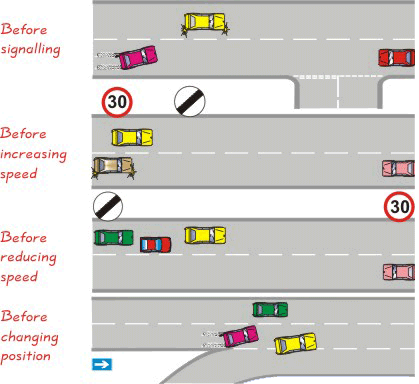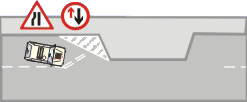Learn to Drive
Driving lesson brief 4. Co-ordination
Introduction
In lesson 4 you will further develop the skills introduced in the first three lessons paying particular attention to your clutch control - the third foundation skill. As with the other foundation skills of steering and gear changing the more attention you pay to the development of it at this early stage the faster you will progress later on.
![]() Lesson objectives
Lesson objectives
By the end of this lesson you should be able to:
- Control the clutch smoothly and accurately
- Hold the car on the clutch on various uphill gradients
- Maintain a crawling pace uphill, downhill and on the flat
- Move off uphill
- Move off downhill
- Move off at an angle
- Negotiate some basic junctions with full support
- Use the MSM routine when overtaking stationary vehicles
- Check mirrors before changing speed, position or direction and give appropriate signals when required
- Correctly answer questions about use of mirrors and signals
Subject brief
As soon as you have mastered the basic skills of moving off on the level, changing gear and steering, you can use them to help with some slightly more complex manoeuvres. During this lesson you will learn how to move off uphill, down hill and at an angle from behind a parked vehicle. You will also learn how to overtake stationary vehicles and improve your mirror and signal use.
Moving off stage 2
 Uphill
Uphill
Use more gas when setting the gas. This will give you the power needed to move away uphill slowly and smoothly. Release the handbrake gently. If the car rolls back, bring the clutch up a little more.
Downhill
 No gas! Let gravity do the hard work for you. Control the speed with the foot brake bringing the clutch up gently as soon as possible. The steeper the gradient the higher the gear you should start in.
No gas! Let gravity do the hard work for you. Control the speed with the foot brake bringing the clutch up gently as soon as possible. The steeper the gradient the higher the gear you should start in.
At an angle
 You may need a signal, even if you think there is no-one to benefit. When moving off at an angle it is harder to see and be seen. Check your blind spot at least twice.
You may need a signal, even if you think there is no-one to benefit. When moving off at an angle it is harder to see and be seen. Check your blind spot at least twice.
 Because you are moving off slowly, other vehicles may approach. Use clutch-control to keep your speed down until you have straightened your wheels.
Because you are moving off slowly, other vehicles may approach. Use clutch-control to keep your speed down until you have straightened your wheels.
Mirror use
 When using the mirrors you have to be careful not to take your eyes off the road ahead for too long. Use quick glances and minimal head movement. Register what you see. Are there any vehicles behind or to the side? How fast are they travelling? How close are they? Are they signalling? Once you have collected this information consider whether they will affect you and whether you need to take any action. As a minimum you need to know this before you change (or signal your intention to change) the cars position, direction or speed. If you are stationary you also need to know this before you open the car doors. Below are some examples showing you why you need to use your mirrors frequently and certainly before signalling or changing the cars position, direction or speed.
When using the mirrors you have to be careful not to take your eyes off the road ahead for too long. Use quick glances and minimal head movement. Register what you see. Are there any vehicles behind or to the side? How fast are they travelling? How close are they? Are they signalling? Once you have collected this information consider whether they will affect you and whether you need to take any action. As a minimum you need to know this before you change (or signal your intention to change) the cars position, direction or speed. If you are stationary you also need to know this before you open the car doors. Below are some examples showing you why you need to use your mirrors frequently and certainly before signalling or changing the cars position, direction or speed.

Signal use
![]()
Signals should only be used to help or warn other road users (including pedestrians)
of your intended actions or your presence. If other road users will not benefit from a signal then a signal may not be necessary. See The Highway Code for the precise meaning of all these signals. Timing your signal is important. Too early and it may be misleading. Too late and other road users may not see or hear it, or have time to react to it. Signals can also be given by hand as shown below.

Meeting and overtaking stationary vehicles
When you approach stationary vehicles use the Mirrors-Signal-Manoeuvre routine. Check your mirrors to see if it is safe to give a signal and if so determine whether it would benefit anyone. Move out to just left of the centre of the road to gain a better view of any oncoming traffic. If you cannot overtake the stationary vehicles without affecting any oncoming traffic slow down and be prepared to stop just left of the centre of the road about two car lengths from the rear of the stationary vehicle.

Meeting traffic
On busy housing estates you can sometimes be confronted with the problem of meeting traffic head on where it is difficult to determine who has priority or where your view is very restricted or where the gap you intend to proceed through is very narrow. Anticipation and common courtesy play an important role.

Try to ensure that you are seen and if possible obtain eye contact with the other road users. Assess the speed and distance of the approaching vehicle. If you are confident that you will arrive earlier than the oncoming vehicle it is likely that the other driver will give you priority but don’t assume it. Keep observing the other drivers actions carefully. The narrower the gap and the more pedestrians that are about the slower your speed should be.
Passing places
On single track roads you will often find passing places to allow oncoming vehicles to pass. If the passing place is on your left hand side then you would normally wait in the passing place area. If it is on your right hand side you would normally wait opposite the passing place in such a position that the oncoming vehicle could move into the passing place area.

Traffic calming measures

In housing estates it is becoming more common to find various types of traffic c alming measures. The most common one is referred to as the “sleeping policeman” . This is simply a hump in the road. Normally the speed limit in such an area would be 20 mph or less.
 You may also find other types of traffic calming measures such as extended causeways. These can be treated in much the same way as a parked car.
You may also find other types of traffic calming measures such as extended causeways. These can be treated in much the same way as a parked car.
Highway code practical references
Rules: 110-112, 152-156, 161-163, 212 and 213.
Page: 103